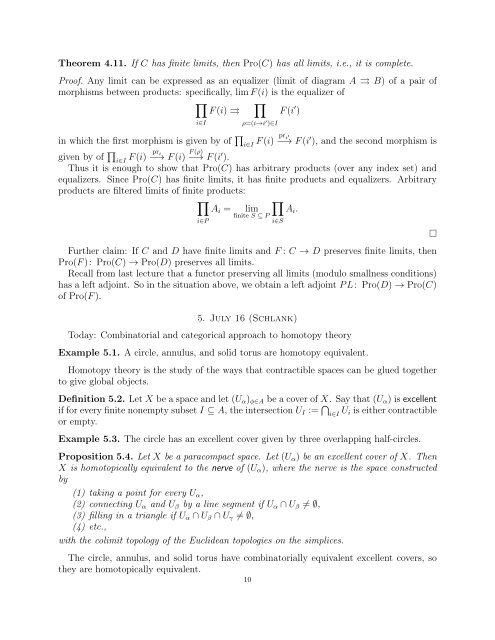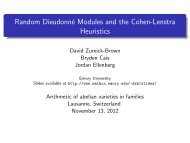alternative lecture notes - Rational points and algebraic cycles
alternative lecture notes - Rational points and algebraic cycles
alternative lecture notes - Rational points and algebraic cycles
You also want an ePaper? Increase the reach of your titles
YUMPU automatically turns print PDFs into web optimized ePapers that Google loves.
Theorem 4.11. If C has finite limits, then Pro(C) has all limits, i.e., it is complete.<br />
Proof. Any limit can be expressed as an equalizer (limit of diagram A ⇒ B) of a pair of<br />
morphisms between products: specifically, lim F (i) is the equalizer of<br />
∏<br />
F (i) ⇒<br />
∏<br />
F (i ′ )<br />
i∈I<br />
ρ=(i→i ′ )∈I<br />
in which the first morphism is given by of ∏ i∈I F (i) pr i<br />
−→ ′<br />
F (i ′ ), <strong>and</strong> the second morphism is<br />
given by of ∏ i∈I F (i) pr i<br />
−→ F (i) −→ F (ρ)<br />
F (i ′ ).<br />
Thus it is enough to show that Pro(C) has arbitrary products (over any index set) <strong>and</strong><br />
equalizers. Since Pro(C) has finite limits, it has finite products <strong>and</strong> equalizers. Arbitrary<br />
products are filtered limits of finite products:<br />
∏<br />
∏<br />
A i =<br />
A i .<br />
i∈P<br />
lim<br />
finite S ⊆ P<br />
Further claim: If C <strong>and</strong> D have finite limits <strong>and</strong> F : C → D preserves finite limits, then<br />
Pro(F ): Pro(C) → Pro(D) preserves all limits.<br />
Recall from last <strong>lecture</strong> that a functor preserving all limits (modulo smallness conditions)<br />
has a left adjoint. So in the situation above, we obtain a left adjoint P L: Pro(D) → Pro(C)<br />
of Pro(F ).<br />
i∈S<br />
5. July 16 (Schlank)<br />
Today: Combinatorial <strong>and</strong> categorical approach to homotopy theory<br />
Example 5.1. A circle, annulus, <strong>and</strong> solid torus are homotopy equivalent.<br />
Homotopy theory is the study of the ways that contractible spaces can be glued together<br />
to give global objects.<br />
Definition 5.2. Let X be a space <strong>and</strong> let (U α ) φ∈A be a cover of X. Say that (U α ) is excellent<br />
if for every finite nonempty subset I ⊆ A, the intersection U I := ⋂ i∈I U i is either contractible<br />
or empty.<br />
Example 5.3. The circle has an excellent cover given by three overlapping half-circles.<br />
Proposition 5.4. Let X be a paracompact space. Let (U α ) be an excellent cover of X. Then<br />
X is homotopically equivalent to the nerve of (U α ), where the nerve is the space constructed<br />
by<br />
(1) taking a point for every U α ,<br />
(2) connecting U α <strong>and</strong> U β by a line segment if U α ∩ U β ≠ ∅,<br />
(3) filling in a triangle if U α ∩ U β ∩ U γ ≠ ∅,<br />
(4) etc.,<br />
with the colimit topology of the Euclidean topologies on the simplices.<br />
The circle, annulus, <strong>and</strong> solid torus have combinatorially equivalent excellent covers, so<br />
they are homotopically equivalent.<br />
10<br />
□



